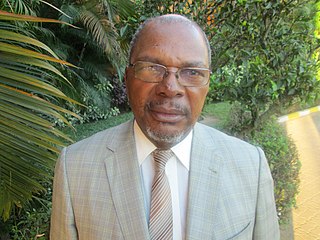| Independence Square | |
 | |
| Location | Maputo, Mozambique |
|---|---|
| Coordinates | 25°58′09″S32°34′24″E / 25.9691°S 32.5732°E Coordinates: 25°58′09″S32°34′24″E / 25.9691°S 32.5732°E |
Praça da Independência (English: Independence Square) is a public square and focal point of Maputo, Mozambique. [1] It was built by the Portuguese as Praça Mouzinho de Albuquerque (Mouzinho de Albuquerque Square) and was dominated by a statue of Mouzinho de Albuquerque, the former governor-general of Portuguese Mozambique. The statue of Mouzinho on horseback was inaugurated in 1940. After the independence of Mozambique in 1975 the square was renamed Praça da Independência, and the statue of Mouzinho de Albuquerque was removed to Fortaleza de Nossa Senhora da Conceição and replaced by a statue of Samora Machel (1933-1986), the first president of Mozambique. [2] The square is now dominated by the much larger Samora Machel Statue, which was built and dedicated in 2011.

English is a West Germanic language that was first spoken in early medieval England and eventually became a global lingua franca. It is named after the Angles, one of the Germanic tribes that migrated to the area of Great Britain that later took their name, as England. Both names derive from Anglia, a peninsula in the Baltic Sea. The language is closely related to Frisian and Low Saxon, and its vocabulary has been significantly influenced by other Germanic languages, particularly Norse, and to a greater extent by Latin and French.

Maputo, officially named Lourenço Marques until 1976, is the capital and most populous city of Mozambique. Located near the southern end of the country, it is positioned within 120 km of the Eswatini and South Africa borders. The city has a population of 1,101,170 distributed over a land area of 347 km2. The Maputo metropolitan area includes the neighbouring city of Matola, and has a total population of 2,717,437. Maputo is a port city, with an economy centered around commerce. It is also noted for its vibrant cultural scene and distinctive, eclectic architecture.

Mozambique, officially the Republic of Mozambique, is a country located in Southeast Africa bordered by the Indian Ocean to the east, Tanzania to the north, Malawi and Zambia to the northwest, Zimbabwe to the west, and Eswatini (Swaziland) and South Africa to the southwest. The sovereign state is separated from the Comoros, Mayotte and Madagascar by the Mozambique Channel to the east. The capital of Mozambique is Maputo while Matola is the largest city, being a suburb of Maputo.
Praça da Independência is flanked to the north by the Maputo City Hall and to the east by Cathedral of Our Lady of the Immaculate Conception. Iron House, designed by Gustave Eiffel for the governor of Mozambique, is located just off the square. Tunduru Gardens, designed in 1885 by British gardener Thomas Honney, is located one block south of the square. [2]

Maputo City Hall (Portuguese: Edifício do Conselho Municipal de Maputo, is the seat of the local government of the capital of Mozambique. The neoclassical building is located at the head of Independence Square, and was erected in 1947.

Alexandre Gustave Eiffel was a French civil engineer. A graduate of École Centrale Paris, he made his name building various bridges for the French railway network, most famously the Garabit viaduct. He is best known for the world-famous Eiffel Tower, built for the 1889 Universal Exposition in Paris, and his contribution to building the Statue of Liberty in New York. After his retirement from engineering, Eiffel focused on research into meteorology and aerodynamics, making significant contributions in both fields.

The Tunduru Gardens is public park and garden in downtown Maputo, Mozambique. It was designed in 1885 by British gardener Thomas Honney. It is home to tennis courts owned by the Mozambique Tennis Federation.













